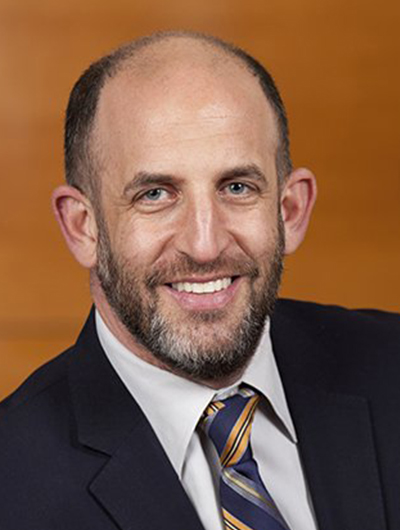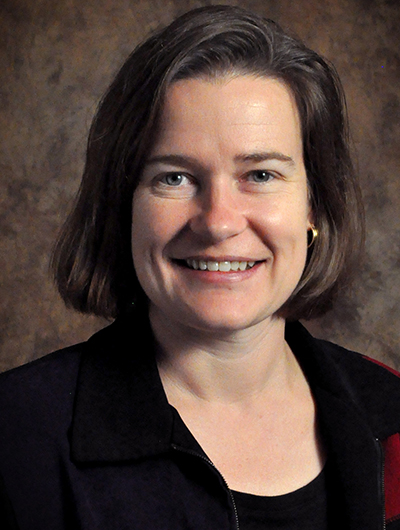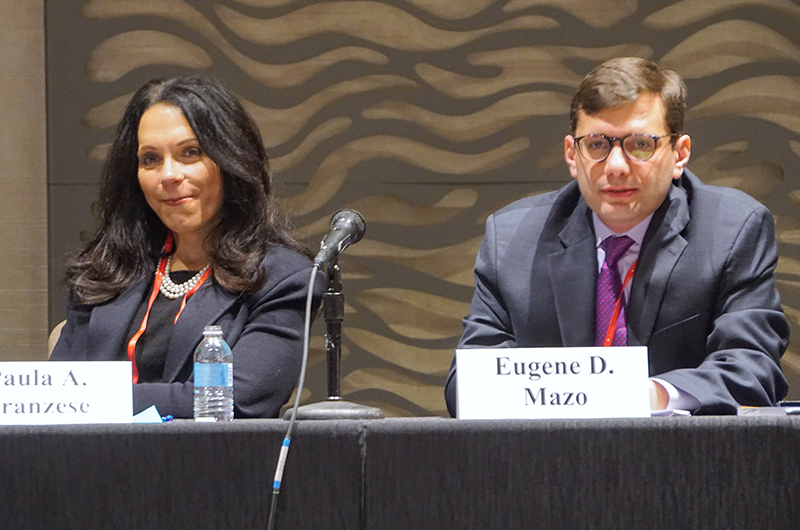The Section on New Law Professors promotes the communication of ideas, interests, and activities among members of the section and makes recommendations to the Association on matters concerning new law professors.
Chair: Dov Waisman, Southwestern Law School
Chair-Elect: Mary Leto Pareja, University of New Mexico School of Law
 Dov Waisman, Southwestern Law School. Photo courtesy of Southwestern Law School.
Dov Waisman, Southwestern Law School. Photo courtesy of Southwestern Law School. Mary Leto Pareja, University of New Mexico School of Law. Photo courtesy of University of New Mexico School of Law.
Mary Leto Pareja, University of New Mexico School of Law. Photo courtesy of University of New Mexico School of Law.What can you tell us about the membership of the Section on New Law Professors and their work?
Dov Waisman: Most of our members join the section as new law professors. Some of them decide to stay involved because they care about Annual Meeting programming for new law teachers. Others want to serve on the executive committee because they found the section useful back when they were first law professors. I don’t think it’s correct to say that all or even the vast majority of the members are actually new law professors. New law professors may drive the membership, but there are also more seasoned law professors that care about AALS programming and other opportunities for new law professors.
Mary Leto Pareja: The section has evolved over the last decade; I know a little bit about how it started because one of my colleagues was in the group that started it 16 years ago. New people who went to the AALS Annual Meeting for the first time felt very lost. They didn’t know what to do, how to network, what programs to go to. They found themselves relying on each other as a support, which I think is normal. Eventually, they decided to formalize this section as a place for new law professors where they knew they belonged, and they could find guidance on how to get the most out of AALS.
It began as more of a support group. As AALS has taken on the task of providing more programming specific to new teachers, I think the nature of our section has evolved.
How many years of experience do you consider to be in the “new law teacher” category?
DW: I would say it’s any amount of time pre-tenure, for folks on that track. That could be, depending on the institution and their particular case, as long as five years. For folks who are not on the tenure track, one to five years.
In my experience, most of the feeling of “new-ness” happens in the first three years—that’s when I got the most benefit from section programming at the Annual Meeting. By the time you’re three years into teaching and scholarship, you usually have your feet under you. You have direction. You’ve probably learned some painful lessons. Even if you are still pre-tenure, you no longer feel like the total newcomer that our programming is mostly directed to.
MLP: That seems right, though I’m always surprised at how many tenured or long-time teachers come to our programming, particularly when we put on teaching panels. Innovation in teaching is the expected norm for newer faculty. We find many seasoned professors are interested in learning about new teaching techniques or new ways of thinking about teaching.
We also attract a small subset of people who come to our programming to become section members so they can network. These folks may be visiting professors, fellows, or adjuncts who are new and still trying to break in because they don’t have a permanent position and are trying to get an appointment. It makes sense, because there are so many people in that position right now. If the starting point is that all-important first permanent position, our experience range might be more like negative two or three years through three or five years.
There seems to be a difference between truly new law professors and early-career law professors. Your purpose as a section is to support the truly new faculty members.
DW: The section is really for folks who are doing these things—teaching class, writing—for the first time. For most people, what they’re working on as a new professor is not their first or even second piece of scholarship, but they are still in the process of defining their research agenda and who they are as a scholar. The section is targeted for folks who are very early on in those processes.
For example, I got tenure last year after four years in the tenure track and six years before that teaching legal writing. I still consider myself early career in the sense that I haven’t taught the wide range of classes that I’d like to. I’ve defined a research agenda and written a number of pieces in one area, but I would like to branch out to others. Still, most of the programming for this section is not targeted at folks like me. This is a section for new law professors and not just early-career law professors.
We do occasionally, as Mary said, provide programming that even mid- or late-career professors find valuable. Programs related to teaching, for example, even if they are about revisiting the fundamentals of the modified Socratic method rather than something new and dynamic. There are folks who care so much about their teaching that they will attend these programs, even if they are 20 or 30 years into the profession, because they still want to get better.
What are some important conversations happening right now regarding new law faculty?
MLP: I think the three pillars of an academic career—teaching, scholarship, and service—have been relatively static, because that is how we’re judged for tenure. That’s what we need to be concerned about as new law professors embarking on the tenure track, so those have remained the major conversations.
Teaching and scholarship are more often the non-negotiable parts, but I think where the conversation has shifted is in some of the newer ideas about combining service as part of either scholarship or teaching. This comes mainly from the clinical area, though not exclusively, and has been a contribution from newer professors who are interested in those styles of learning and teaching.
DW: Also, the emphasis on the different pillars can differ from school to school. Here at Southwestern Law School, traditionally our focus has been on teaching, but scholarship has become much more important in the last 20-30 years. At the same time, teaching continues to be extremely important for tenure. That may not be the case at other law schools. People who want to get tenure will try to do all three things—scholarship, teaching, and service—well, but should also take their school’s particular emphasis into account.
MLP: When we design our section newsletters and Annual Meeting programming, we try to speak to people at different kinds of institutions. For example, one of our speakers at the 2018 Annual Meeting talked about incorporating non-traditional styles of teaching. What I really appreciated was that he talked about making sure that’s valued by senior faculty who will be voting for you on tenure. We try to strike that balance—this may be new and exciting, but you still have to take into account the particular emphases that your institution has and their expectations for teachers. Be innovative, but do it in a way that the people who are voting on you can appreciate.
DW: I’ve heard some folks say that in order to get hired into a tenure-track position these days, you must have a pretty well-thought out research agenda because you’ll need to talk about it with hiring committees and during job talks. You should already have one or more articles published. That may have not been true 20 years ago where you could be hired on the tenure track just by doing well in law school and working for your school’s law review or having a clerkship. Now, it’s a different situation at many institutions.
What changes in the experience of law school teaching have you seen as a direct or indirect result of the section?
DW: I think the barometer of the section’s success is that we have a pretty good section membership—around 800 people. We have excellent attendance at our Annual Meeting panels, whether they are focused on scholarship or teaching. I take those two facts to be suggestive that we’re making a valuable contribution.
MLP: Anecdotally, it seems we are making a difference from the long view. We were started in 2002 because there was a dearth of programming focused on new professors. Obviously, AALS has taken up that mantle with their annual Workshop for New Law School Teachers. There’s also been a trend toward providing more support and professional development for newer professors, which is tied in with diversity initiatives. I think we’ve played a part in that because we’ve demonstrated desire for it in some respect.
DW: I went to the AALS Workshop for New Law School Teachers when I started teaching legal writing back in 2007. Most folks only go to that once, in their very first year. You’re still a deer in the headlights for a few years after that, so it’s good to have somewhere else to go with continuing questions. I’ve learned a lot since 2007, but I still have a lot left to learn. The section provides that opportunity.
How do your section members interact and collaborate outside of the annual meetings?
MLP: We produce an annual newsletter. I did the last one, focused on “Engaging in Social Activism as a Law Professor,” which was a different topic for us. I was struck by the conversations I was having with younger faculty members coming from backgrounds in social or community activism, and people interested in getting more involved in the community. We’ve always done social activism in clinical law teaching, but I’ve been struck lately at the number of people who want to bring social activism into the doctrinal classroom or whose scholarship is an offshoot of their outside service activities. We published a newsletter specifically devoted to using your scholarship as a platform for social activism: what it looks like, the risks and the rewards (especially as a pre-tenure teacher), and being heavily involved in the community in addition to what you do as a scholar.
DW: We also have the section listserv, which is useful for communicating around the time of the Annual Meeting and for disseminating the newsletter. Its main purpose is spreading the word about opportunities for new law teachers. We are often contacted by people from conferences or workshops that target newer scholars because our section is the best way to reach that audience. We also pass quite a few “calls for papers” and scholarship opportunities along.
How does your section support the scholarship of your members, and engage in mentorship of new law faculty?
DW: Longtime section members, particularly current and former executive committee members, are presented as resources for any new law professor. We list everyone on our section website that way. Membership in our section also gets you access to the Teaching Materials Network, which is sponsored by Stetson Law School. It’s a database where you can select your course and the case book you’re using, press a button, and receive a list of professors who’ve taught that course using that casebook. Then those professors can serve as a resource if you want their PowerPoint slides or advice about syllabus, et cetera.
We don’t have a formal mechanism for mentorship, but I think my own view is that informal mentorship is the best anyway. When people find each other, those tend to make some of the most lasting mentorship connections. I like to think that our section is a place where those kinds of meetings can happen.
MLP: I think that’s right, and I don’t know if I would advocate for anything more formal. Every once in a while, we have an Annual Meeting program or newsletter focus on how to find a mentor and how to make the best use of a mentor once you find one.
What programming do you have in the works for the next AALS Annual Meeting?
DW: We’re co-sponsoring a panel with the Section on Law & the Social Sciences and we hope that a lot of our members who are interested in an empirical focus for their scholarship will come to that panel.
We’re spending most of our time now working on our own program, which we’ve tentatively agreed will focus on how to teach to all different types of students. We hope to cover engaging students with different interests, students from different backgrounds, and students with different strengths or different levels of aptitudes.
What is your vision for the section, this year and in the years to come? What new initiatives, project-based or ongoing, would you like to see as part of the section?
MLP: I would like us to be more actively involved in collaboration with different sections and with the umbrella efforts from AALS focused on new law professors. Many substantive academic areas have programming for new law professors, and I believe there’s room for us to be involved in that way. I would like to see us complete simple record-keeping goals, like cleaning up our website and locating old section materials to show where we’ve been and where we’re going.
DW: One possible area for growth is facilitating member-to-member connections and networking. A lot of what we do tends to be dissemination of knowledge and guidance to new law professors from more experienced folks. It would be great if we could make the section more of a communications hub. What if a new faculty member teaching a course for the first time at UC Irvine could connect with a new faculty member teaching the same course at Villanova? When I was starting out teaching contracts, I relied heavily on my colleagues who had already done it. What if I could have been connected to the 10 or 20 other people at AALS member law schools who were also teaching contracts for the first time? Everybody ends up making those connections anyway, but they do it informally. Our section would be a great place to structure that collaboration.
 The Section on New Law Professors program at the 2018 AALS Annual Meeting.
The Section on New Law Professors program at the 2018 AALS Annual Meeting.